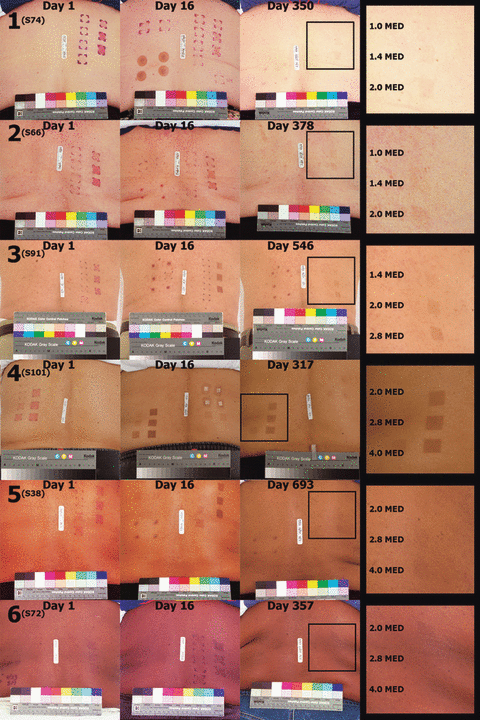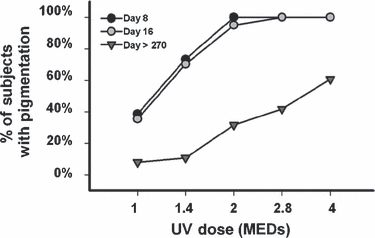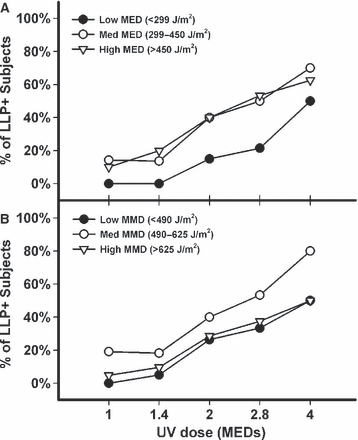Long-lasting pigmentation of human skin, a new look at an overlooked response to UV
Dear Sir,
Induction of melanogenesis by ultraviolet radiation (UV) is a relatively slow process (Tadokoro et al., 2003, 2005;Yamaguchi et al., 2008). UV-induces immediate pigment darkening (within minutes, remaining for hours) (Hönigsmann et al., 1986; Routaboul et al., 1999), persistent pigment darkening (within hours, remaining for days) (Moyal et al., 2000, 2006), and delayed pigmentation (within in days, remaining for weeks) (Ortonne, 1990; Tadokoro et al., 2003, 2005; Young, 2006).
The majority of humans lose UV-induced pigmentation (tan) within a relatively short time; however, a significant segment of the population maintains such pigmentation for many months. However, no systematic studies of long-lasting pigmentation (LLP) have been reported. Anecdotally, people know that pigmentation persists after UV exposure as ‘tan lines’, but the mechanism of this extended pigmentary response has not been elucidated. A literature search revealed only one study reporting pigmentation remaining 6 months after exposure to two minimal erythema doses (MED)(Suh et al., 2007).
We analyzed the persistence of UV-induced pigmentation in humans of different complexion (Figure 1) and analyzed factors that may predispose to LLP. We explored parameters that included gender, age, eye color, hair color, MED, minimal melanogenic dose (MMD), phototype, race/ethnicity, and constitutive pigmentation. Figure 2 shows that virtually all subjects exposed to ≥2 MED developed early pigmentation with a grade of ≥1 on a scale 0–4 (Table S1). A proportion of these subjects showed a pigmentation grade ≥1 at ≥9 months post-exposure. LLP+ subjects typically develop a strong pigmentation within days after UV exposure. This pigmentation remains robust on post-exposure day 16 (Figure 1). Induction of LLP depends on the UV exposure level: only a few of our subjects developed LLP after one MED, but at two MED the proportion of LLP+ subjects was substantial, and it increased with increasing UV dose.

Long-lasting pigmentation (LLP) ≥9 months after ultraviolet exposure in six phototypes (1 – Burns easily, never tans; 2 – Burns easily, tans slightly; 3 – Burns slightly, tans light brown; 4 – Burns slightly, tans moderate brown; 5 – Burns rarely, tans dark brown; 6 – Never burns, tans black). The black squares show the areas with LLP, enlarged on the right side with doses in multiples of minimal erythema doses included. The subject numbers are given in parentheses.

Pigmentation after 1–4 minimal erythema doses of ultraviolet radiation.
Correlations between LLP+ occurrence and the three MED ranges, as defined in Appendix S1, were pronounced (Table 1 and Figure 3A). No subjects with MED <299 J m−2 showed LLP after exposure to <2 MED. Subjects in the higher MED ranges exposed to >2 MED showed LLP frequency of 40–70%. The ‘Unequally Spaced Repeated Measures Linear Model’ (Appendix S1) demonstrated a statistically significant difference from zero, with P < 0.0001, for the independent variable MED. Figure 3B shows frequency of LLP+ subjects in three MMD ranges (Appendix S1). Subjects with higher MMD values were more likely to develop LLP than those with lower MMD values, with statistically significant difference from zero and P = 0.0001. The LLP+ response increased linearly with increasing age, over all ages (statistically significant difference from zero in predicting LLP, P < 0.005). Hence, LLP depends more on MED or MMD than on increasing age. One might expect that propensity to LLP correlates with constitutive pigmentation, phototype, or race/ethnicity. However, we found no statistically significant effect of these parameters on the frequency of the LLP occurrence. The melanin content expressed in milligram eumelanin per ml was not always higher in LLP+ than in LLP− subjects, and showed considerable variability (Table 1).
| Multiple of MED groupsa | LLP | Gender | MED range (J m−2) | MMD range (J m−2)b | Constitutive pigmentation | |||||
|---|---|---|---|---|---|---|---|---|---|---|
| Female | Male | Low<299 | Med299–450 | High>450 | Low<490 | Med490–625 | High>625 | Eumelanin (mg ml−1)mean ± SEM | ||
| 1.0 MED (n = 62) | − | 37 | 20 | 21 | 18 | 18 | 19 | 17 | 20 | 4.80 ± 0.71 |
| + | 3 | 2 | 0 | 3 | 2 | 0 | 4 | 1 | 6.51 ± 4.20 | |
| % | 8 | 9 | 0 | 14 | 10 | 0 | 19 | 5 | ||
| 1.4 MED (n = 64) | − | 36 | 21 | 22 | 19 | 16 | 19 | 18 | 19 | 4.97 ± 0.78 |
| + | 5 | 2 | 0 | 3 | 4 | 1 | 4 | 2 | 4.14 ± 1.07 | |
| % | 12 | 9 | 0 | 14 | 20 | 5 | 18 | 10 | ||
| 2.0 MED (n = 60) | − | 24 | 17 | 17 | 12 | 12 | 14 | 12 | 15 | 5.01 ± 0.92 |
| + | 16 | 3 | 3 | 8 | 8 | 5 | 8 | 6 | 5.11 ± 1.31 | |
| % | 40 | 15 | 15 | 40 | 40 | 26 | 40 | 29 | ||
| 2.8 MED (n = 43) | − | 13 | 12 | 11 | 7 | 7 | 8 | 7 | 10 | 5.11 ± 1.14 |
| + | 14 | 4 | 3 | 7 | 8 | 4 | 8 | 6 | 6.87 ± 1.61 | |
| % | 52 | 25 | 21 | 50 | 53 | 33 | 53 | 38 | ||
| 4.0 MED (n = 28) | − | 5 | 6 | 5 | 3 | 3 | 5 | 2 | 4 | 5.79 ± 1.83 |
| + | 12 | 5 | 5 | 7 | 5 | 5 | 8 | 4 | 5.71 ± 1.36 | |
| % | 71 | 45 | 50 | 70 | 63 | 50 | 80 | 50 | ||
- MMD, minimal melanogenic dose; MED, minimal erythema doses; LLP, long-lasting pigmentation.
- aThe ‘n’ refers to the number of subjects who received the specific dose out of total of 64 subjects.
- bSubject 7 was excluded here because they did not receive a dose large enough to produce a MMD value.

Increasing minimal erythema doses (MED), minimal melanogenic dose (MMD), and frequency of long-lasting pigmentation induction. (A) MED ranges, (B) MMD ranges – as defined in Appendix S1. Total number of subjects, 64; data for 62, 64, 60, 43, and 28 subjects at 1, 1.4, 2, 2.8, and 4 MED, respectively.
Photographs of the study areas on the backs of subjects representing the six phototypes are shown in Figure 1. Clearly, the LLP is more pronounced in darker phototypes but, with time, minimal perceptible pigmentation becomes harder to discern in the darker skin. Phototypes 1 and 2 showed the lowest, and phototypes 5 and 6 the highest tendency to be LLP+. LLP+ response occurred in all five racial/ethnic groups studied; however the number of subjects was too small to analyze the effects of race/ethnicity on predisposition to LLP.
Our observations indicate that after UV exposure humans can be divided into three classes: those who never develop pigmentation, those who develop pigmentation but lose it within 9 months and those who develop pigmentation that persists for at least 9 months (LLP). During that time, the pigmentation fades to varying degrees in different LLP+ subjects, nevertheless it remains visible. In our study, 32% of subjects showed LLP after ≥2 MED, while 61% had a LLP response after four MED. Our results are consistent with reports of LLP in Korean individuals (phototypes 3–5) up to 6 months after two MED (Suh et al., 2007). High MED and MMD values are the best predictors of LLP. Also, advancing age may facilitate LLP induction. The relationship of race/ethnicity to LLP needs further evaluation in a larger cohort. We found no statistically significant indication that LLP is related to gender, eye color, hair color, phototype, or constitutive pigmentation (melanin content by reflectance spectroscopy). Clear correlations between MED or MMD with LLP and lack of correlation between phototype and propensity for LLP confirm our earlier conclusions regarding the superiority of MED as a human photosensitivity criterion (Tadokoro et al., 2003).
UV-induced pigmentation could remain visible for a long time if (i) desquamation of the epidermis is retarded or (ii) the activity of the melanogenic system remains elevated. It is important to determine if any or both of these mechanisms (or still another process) is involved since benefits and risks of LLP are unknown and may be significant. On one hand, increased pigmentation may be photoprotective (Yamaguchi et al., 2008; Young, 2006). However, if prolonged activation of the melanogenic system is involved, there is potential risk of uncontrolled proliferation that might lead to melanoma (Gilchrest et al., 1979). Further studies should help to define risks and benefits of LLP, and innovative approaches have been proposed (Aoki et al., 2007; Procaccini et al., 2007). Preliminary explorations in this area have just been reported (Brenner et al., 2009).
Better understanding of LLP should be sought to answer the following critical questions:
- 1
Do any changes in the desquamation rate occur in the skin with LLP?
- 2
Is the spectrum of UV-activated melanogenic factors the same in LLP+ and LLP− skin?
- 3
Is the sequence of activation of melanogenic factors altered in skin with LLP?
- 4
How persistent is the activation of different melanogenic factors?
Acknowledgements
This research was supported by the Office of Science and the Center for Devices and Radiological Health, Food and Drug Administration, and in part by the Intramural Research Program of the National Cancer Institute, National Institutes of Health. The authors wish to express their appreciation to Dr. Katalin S. Korossy and to Julia A. Kniskern, RN, for their dedication and critical contributions to this study.




